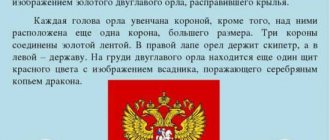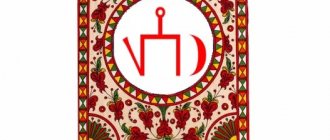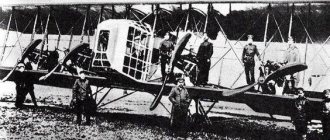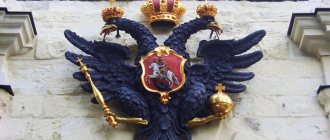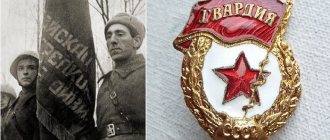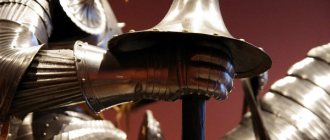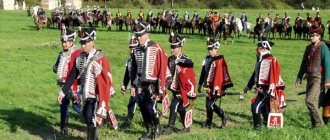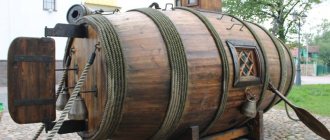The State Emblem of Russia is one of the main symbols of our country, along with the national anthem and the flag of the Russian Federation. It was approved in 1993 by decree of the country's first president, Boris Yeltsin. However, the symbols that are depicted on the coat of arms of Russia have a much longer history, dating back to the period of formation of the Moscow principality. The coat of arms of the Russian Federation depicts a double-headed eagle spreading its wings. What does it symbolize on the Russian coat of arms?
Any state emblem is not only an image on banknotes, documents and police insignia. First of all, the coat of arms is a national symbol intended to unite people living in a given territory.
What does the state emblem of the Russian Federation mean? When did he appear? Was the coat of arms of medieval Rus' similar to the modern one? Why does the Russian eagle have two heads?
The history of the coat of arms of Russia is rich and interesting, but before telling about it, a description of this national symbol should be given.
Symbolism
| It turns out that the coat of arms of the Russian Federation is a fractal. On the scepter there is an eagle holding a scepter, which holds an eagle, etc. |
Three crowns signify the country's sovereignty. The scepter and orb are a symbol of state power and the unity of the state. The author of the most common image of the coat of arms of the Russian Federation is People's Artist Evgeniy Ilyich Ukhnalev. The symbol of the double-headed eagle first appeared in the history of Russia in 1497, although it was found on Tver coins even earlier. The double-headed eagle is a symbol of the Byzantine Empire. The borrowing of this symbol, as well as from Serbia, Albania from Byzantium, is explained by economic, diplomatic, as well as cultural proximity. The heraldic shield became red for the reason that the image of an eagle on red belongs to the Byzantine heraldic tradition, and the image of an eagle on yellow is closer to the Roman heraldic tradition (coat of arms of the Holy Roman Empire).
Why did they change the coat of arms on the website of the Russian government?
There is no official answer regarding the change of coat of arms. Therefore, Internet users put forward their own hypotheses :
- A more strict color scheme fits better into the website design. This is the most plausible version. Especially considering that the design of the site is dominated by blue. From a web design point of view, it goes well with black, which is the color of the new coat of arms;
- was underway to optimize the site . The size of a single-color image of the coat of arms is significantly smaller than a multi-color one. It is possible that the site administration decided to post a “lighter” version of the coat of arms for practical reasons. This will allow the site to open in the browser a little faster;
- Connection with quarantine . Some users noticed that the change from golden color to a darker tone occurred right in the midst of the coronavirus epidemic.
History of the origin of the coat of arms of Russia
Coat of arms of Russia 1497
The process of uniting the disparate principalities began before John III. It was his father, Vasily II Vasilyevich (ruled from 1435 to 1462), who began the process of unifying Russian lands.
Under John III of Moscow, the principality finally gained strength and subjugated Pskov, Novgorod, and Ryazan. During this period, Tver significantly weakened as a center for the unification of lands.
During the reign of John III, the traditions of government began to change. All the nobility in the subject lands lost their privileges. It was during the reign of John III that the veche bell of Novgorod was dismantled and brought to Moscow.
John III also built a new diplomatic policy. He took the title "Sovereign of All Rus'".
| Interesting fact |
| In the XIV-XV centuries, the signs on seals changed quite often. The princes changed the images of horsemen at their own request. Until 1497, the horseman was the main image on seals and coins. So the horseman could be with a sword (“swordsman”), with a spear in his hand (“spearman”), with a falcon in his hand (“falconer”). During the reign of Vasily the Dark, the “spearman” was established - symbolizing St. George the Victorious. |
During this period, John III marries the Byzantine queen Sophia (Zinaida) Fominichna Palaiologos.
“John III wisely adopted for Russia the symbolic coat of arms of the Byzantine Empire: a black double-headed eagle on a yellow field and combined it with the Moscow coat of arms - a horseman (St. George) in white clothes on a white horse, slaying a serpent. The state emblem, according to state law, is recognized as a symbol, a visible distinctive sign of the state itself, emblematically depicted on the state seal, on a coin, on a banner, etc. And as such a symbol, the coat of arms of the state expresses the distinctive idea and principles that the state considers itself called upon to implement.
Due to the use by Tsar John III of the Byzantine coat of arms together with the Moscow coat of arms on the seals of internal and external state acts that have been preserved since 1497, this year is generally considered to be the year of the adoption and merger of the coat of arms of the Byzantine Empire with the coat of arms of the Russian kingdom.” /E.N. Voronets. Kharkiv. 1912/
Thus, the coat of arms appeared at the moment of the emergence of the modern Russian state.
It is definitely impossible to say that the coat of arms appeared in 1497, since the matrices for printing coins lasted for 5-15 years. On a coin from 1497, a spearman was reflected on one side, and a double-headed eagle on the other. But we can say for sure that this period can be limited from 1490 to 1500.
Nicholas I
Coat of arms of Nicholas I
The reign of Nicholas I (1825-1855) was emphatically firm and decisive (suppression of the Decembrist uprising, limitation of the status of Poland). Under him, from 1830, the armorial eagle began to be depicted with sharply raised wings (this remained so until 1917). In 1829, Nicholas I was crowned the Kingdom of Poland, therefore, since 1832, the coat of arms of the Kingdom of Poland has been included in the Russian coat of arms. At the end of the reign of Nicholas I, the manager of the heraldry department, Baron B.V. Kene, tried to give the coat of arms the features of Western European heraldry: the image of the eagle should have become more strict. The coat of arms of Moscow was to be depicted in a French shield; the rider was to be turned, according to heraldic rules, to the left of the viewer. But in 1855, Nicholas I died, and Quesne’s projects were implemented only under Alexander II.
Theories of the appearance of the double-headed eagle in Russia as an official symbol
There are several points of view on the appearance of images of a double-headed eagle in Russia (Rus). Firstly, the eagle was originally used on coins and seals of Tver and Moscow. Secondly, the eagle began to be used at approximately the same time - approximately the end of the 15th century, together with images of a spearman.
Currently, there are three theories explaining the appearance of the double-headed eagle on the seals of kings.
Byzantine theory
This theory was actively supported by Russian monarchists and many historians. In most sources it remains the only one. According to this theory, the double-headed eagle began to be used after the marriage of John III with the Byzantine queen Sophia (Zinaida) Fominichna Palaeologus.
| Coat of arms of Palaiologos |
This theory is also supported by the fact that the marriage of the monarchs coincided with the appearance in Rus' of coins combining the image of a spearman on one side and a double-headed eagle on the other.
Theory of symbol borrowing in the Holy Roman Empire
In the Holy Roman Empire until 1440, a regular eagle was used. After this period it changes to a double-headed eagle.
Some historians and heraldists note that in Muscovy the double-headed eagle could have been adopted for use under the influence of the Holy Roman Empire.
The theory of symbol borrowing in the Balkan countries
The third version of the borrowing of the symbol is the borrowing of the double-headed eagle from a number of Balkan countries: Bulgaria, Serbia.
Each of the theories has its own right to exist.
You can read more about the appearance of the double-headed eagle on the coats of arms of the world in a separate article: eagle in heraldry.
Coat of arms of Russia 1539
Since 1539, Russian heraldry has been influenced by the Central European heraldic tradition. In accordance with it, the eagle’s beaks are open and its tongue is sticking out. This position of the bird is called: “armed”
Coat of arms of Russia 1560
During this period, the double-headed eagle was transferred from the reverse of the seal to the obverse. Its meaning is fixed in Russian heraldry.
On the reverse side, a mythological animal appears for the first time: the unicorn.
Coat of arms of Russia 1562
From this period, a shield appears on the double-headed eagle’s chest (at first of a baroque heraldic form), on which there is a rider with a spear, striking a dragon on one side (the main side) and a unicorn on the shield on the other (reverse side).
Coat of arms of Russia 1577
This version of the coat of arms differs from the previous one in that there is now one jagged crown above the eagle’s heads, which symbolizes the unity and supremacy of the Moscow Prince Ivan IV the Terrible over the Russian lands.
On this seal, on each side there are emblems of 12 Russian lands (in total, 24 emblems on both sides).
Unicorn on state seals
The unicorn first appeared as one of the symbols of state power in 1560. The meaning of this symbol is still not clear. It appeared on state seals several more times - during the reigns of Boris Godunov, False Dmitry, Mikhail Fedorovich and Alexei Mikhailovich. After 1646 this symbol was not used.
Coat of arms of Russia 1605
During the Time of Troubles, the state emblem was brought into line with the European heraldic tradition for a short period of time. The spearman was turned to the left, and crowns were again placed above the heads of the eagles. The eagle's wings began to be depicted spread out.
Coat of arms of Russia 1654
After the end of the Time of Troubles and the reign of the new Romanov dynasty in Russia, the state seal, coat of arms and other symbols changed.
The main changes were that, in accordance with European heraldic tradition, the eagle's wings were now spread out. In accordance with Russian emblematic tradition, the spearman is turned to the right. Three crowns were finally placed above the eagle's heads. The beaks of the eagle's heads are open. The scepter and orb are clutched in the paws.
It was under Emperor Alexei Mikhailovich that a description of the state coat of arms first appeared.
“The eastern eagle shines with three crowns: Faith, Hope, Love for God. Krile is spread out - it embraces all the worlds of the end: the north, the south, from the east right up to the west, the sun is kindly covered with outstretched wings” (“Slavic Bible” 1663, poetic form of description).
The second description is given in the state normative act: the decree “On the royal title and the state seal” dated December 14, 1667:
“The double-headed eagle is the coat of arms of the Great Sovereign, Tsar and Grand Duke Alexei Mikhailovich of All Great, Little, and White Russia, the Samozherzh, His Royal Majesty of the Russian Kingdom, on which (the coat of arms - editor's note) three crowns are depicted, signifying the three great Kazan , Astrakhan, Siberian glorious kingdoms, submitting to the God-protected and highest power of His Royal Majesty the Most Gracious Sovereign and command... on the Persians (on the chest - editor's note) the image of the heir (this is how the rider was interpreted - editor's note); in the claws (claws - editor's note) a scepter and an apple (power - editor's note), and reveals the most gracious Sovereign, His Royal Majesty the Autocrat and Possessor."
Coat of arms of Russia during the reign of Peter the Great
Since 1710, the horseman on the Russian coat of arms has been increasingly associated with St. George the Victorious, and not with a simple spear-bearer. Also during the reign of Peter the Great, crowns on the eagle’s head began to be depicted in the form of imperial crowns. Petal and other crowns were no longer used from this point on.
| Matrix of the state seal 1710 Master - Haupt | Matrix of the state seal 1712 Master - Becker |
It was under Peter I that the coat of arms adopted the following color design: the double-headed eagle became black; beak, eyes, tongue, paws, golden-colored attributes; the field became golden; the affected dragon turned black; St. George the Victorious was depicted in silver. This color scheme was followed by all subsequent rulers from the House of Romanov.
Under Peter the Great, the coat of arms received its first official description. Under the leadership of Count B.Kh. von Minich can still be found today: “The State Coat of Arms in the old way: a double-headed eagle, black, on the heads of the crown, and at the top in the middle there is a large Imperial crown - gold; in the middle of that eagle is George on a white horse, defeating the serpent: the epancha (cloak - editor's note) and spear are yellow, the crown (crown crowning St. George - editor's note) is yellow, the serpent is black; the field around (that is, around the double-headed eagle - editor's note) is white, and in the middle (that is, under St. George - editor's note) is red."
In the 17th century, the state emblem underwent a large number of changes and variations.
Coats of arms of Russia under Paul I
| Coat of arms of Russia 1799 | Complete coat of arms of Russia 1800 |
After Peter the Great, the coat of arms of Russia changed significantly under Paul I. It was under this ruler that all variants of the coat of arms of Russia were unified and brought to one form
This year the Maltese cross appears on the coat of arms of Russia. This year Russia took the island of Malta under its protection. The following year, Britain captured the island. Paul ordered the transfer of the Order of Malta to Russia. The fact that the Maltese cross remained on the Russian coat of arms meant its claim to this territory.
Also, under Paul I, a full coat of arms with shield holders appeared, made in accordance with the traditions of that time. At this time, the “Manifesto on the full coat of arms of the All-Russian Empire” was prepared. The large coat of arms contained 43 coats of arms of the lands that were part of it. The archangels Michael and Gabriel became the shield holders. The manifesto never came into force for the reason that the head of state was killed.
State emblem, intended for military purposes from 1801 to 1825.
This type of coat of arms first appeared under Alexander I. It was different from the standard coat of arms. The main difference was that the coats of arms of the dependent territories (Finland, Astrakhan, Kazan, etc.) were not placed on the military coat of arms. The shield on the eagle's chest had a distinct heraldic shape from the French shield. The wings were not raised up.
Under the next emperor, Nicholas I, this tradition was consolidated.
Coat of arms of Russia from 1825 to 1855.
This coat of arms existed during the reign of Nicholas I.
Köhne reform (1857)
| Bernhard Köhne (Boris Vasilievich Köhne) |
Köhne Bernhard was born in 1817 in Berlin. In 1844 he was appointed to the position of curator of the numismatic department of the Hermitage. In 1857, Köhne was appointed head of the armorial department of the heraldry department.
The book “Armorial of the Russian Empire” (XI-XIII) was published under the editorship of Koehne.
It was Bernhard Köhne who organized the coats of arms of the territories of the Russian Empire. It is believed that it was under the influence of Koehne that the state received a new state flag, black, yellow and white. Although in fact, Koehne used only already developed historical materials (it is worth paying attention to the design of the large full coat of arms of the Russian Empire from 1800; on it, shield holders support a yellow flag with a black eagle with their free hand).
Köhne, in accordance with the heraldic tradition that had developed at that time, brought all coats of arms into conformity. The first coat of arms corrected by Koehne was the coat of arms of the Russian Empire. It was under him that three versions of the coat of arms were formed: large, medium, small.
Drawing of the coat of arms of the Russian Empire in 1856
As mentioned above, under the leadership of Köhne, the artist Alexander Fadeev created a new design of the coat of arms.
Main changes in the coat of arms:
- drawing of a double-headed eagle;
- added the number of shields (increased from six to eight) on the eagle’s wings;
- the rider slaying the dragon now faces heraldic right (towards the eagle's right wing).
Alexander I approved this coat of arms on December 8, 1856.
Coat of arms of the Russian Empire 1857
A year later, under the leadership of Köhne, the medium and large coats of arms were also prepared.
Coat of arms of the Russian Empire 1882
| Small coat of arms | Middle coat of arms | Great coat of arms |
In this coat of arms, the main elements of the coat of arms of the previous version were retained. The color of the crowns has changed - it is now silver.
A detailed list of the coats of arms of the lands that are part of the large coat of arms.
Coat of arms of 1917 (seal of the provisional government)
All attributes of monarchy were removed from the seal, and the shields were removed.
The sketch of the emblem-coat of arms was made by Vladislav Lukomsky, Sergei Troinitsky, Georgy Narbut, Ivan Bilibin.
An interesting fact is that the emblem was used on the reverse of coins issued by the Central Bank of Russia at the end of the 20th century. - beginning of XXI. Many people mistakenly consider this emblem to be the state emblem, which is a misconception.
From Peter I to Alexander II
Coat of arms of Peter I
Peter I ascended the Russian throne in 1682. During his reign, the Russian Empire became an equal among the leading powers of Europe. Under him, according to heraldic rules, the coat of arms began to be depicted as black (before that it was depicted as gold). The eagle has become not only a decoration of state papers, but also a symbol of strength and power. In 1721, Peter I accepted the imperial title, and imperial crowns began to be depicted on coats of arms instead of royal crowns. In 1722, he established the office of the King of Arms and the position of King of Arms. The state emblem under Peter I also underwent other changes: in addition to changing the color of the eagle, shields with the coats of arms of the Grand Duchies and Kingdoms were placed on its wings. On the right wing there were shields with the coats of arms (from top to bottom): Kyiv, Novgorod, Astrakhan; on the left wing: Vladimir, Siberian, Kazan. It was under Peter I that a complex of attributes of the coat of arms eagle emerged. And after Russia entered the “expanses of Siberia and the Far East,” the double-headed eagle began to symbolize the inseparability of European and Asian Russia under one imperial crown, since one crowned head looks to the west, the other to the east. The era after Peter I is known as the era of palace coups. In the 30s of the 18th century. the leadership of the state was dominated by immigrants from Germany, which did not contribute to the strengthening of the country. In 1736, Empress Anna Ioannovna invited a Swiss by birth, the Swedish engraver I. K. Gedlinger, who engraved the State Seal by 1740, which was used with minor changes until 1856.
Until the end of the 18th century. There were no special changes in the design of the coat of arms, but during the times of Elizabeth Petrovna and Catherine the Great, the eagle looked more like an eagle.
Coat of arms of Catherine I
Sources
- Coats of arms of cities, provinces, regions and towns of the Russian Empire, included in the complete collection of laws from 1649 to 1900/ compiled. P. P. von-Winkler;
- Coats of arms and symbols of the Belgorod region;
- State symbols of Russia (kremlin.ru);
- “How the black, yellow and white colors of Russian heraldic symbolization came about and what they mean” Explained by E.N. Voronets. Kharkiv. 1912
- Manifesto of Emperor Paul I on the full coat of arms of the All-Russian Empire. Approved December 16, 1800;
- Website of the Heraldic Council under the President of the Russian Federation;
- Decree of the President of the Russian Federation of November 30, 1993 N 2050 (as amended on September 25, 1999);
- Decree “On the royal title and the state seal” of December 14, 1667.
- "Encyclopedic Dictionary of Brockhaus and Efron."
- Some of the photographs were provided by Oransky A.V. and is prohibited from copying.
Paul I
Coat of arms of Russia with the Maltese cross
Having become emperor, Paul I immediately tried to modify the Russian coat of arms. By decree of April 5, 1797, the double-headed eagle became an integral part of the coat of arms of the imperial family. But since Paul I was the Master of the Order of Malta, this could not but be reflected in the state emblem. In 1799, Emperor Paul I issued a decree on the image of a double-headed eagle with a Maltese cross on the chest. The cross was placed on the eagle's chest under the Moscow coat of arms ("indigenous coat of arms of Russia"). The emperor is also making an attempt to develop and introduce a complete coat of arms of the Russian Empire. At the upper end of this cross was placed the crown of the Grand Master. In 1800, he proposed a complex coat of arms, on which forty-three coats of arms were placed in a multi-field shield and on nine small shields. However, they did not have time to adopt this coat of arms before Paul’s death. Paul I was also the founder of the Great Russian Coat of Arms. The Manifesto of December 16, 1800 gives its full description. The large Russian coat of arms was supposed to symbolize the internal unity and power of Russia. However, Paul I's project was not implemented. Alexander I, having become emperor in 1801, abolished the Maltese cross on the state emblem. But under Alexander I, on the coat of arms, the eagle’s wings are spread wide to the side, and the feathers are lowered down. One head is more inclined than the other. Instead of a scepter and an orb, new attributes appear in the eagle’s paws: a torch, peruns (thunder arrows), a laurel wreath (sometimes a branch), a lictor’s bun intertwined with ribbons.
Links
- The coat of arms of Russia on the website of the President of the Russian Federation
(aircraft modernization) • Armaments • (infantry weapons • military equipment • aviation • armored vehicles • T-14 tank) • Navy • Military districtsSymbolismCoat of arms of Russia • Flag of Russia • Motto of Russia • Anthem of Russia • Ribbon of St. George • National symbols of RussiaStoryRulers of Russia
• The myth of the centuries-old backwardness of Russia • Changes in borders (territorial disputes) • The future of Russia • Reform of the Russian Constitution (chronology • text of amendments • voting)EconomyMajor projects • Industry • Agriculture • Electric power industry • Tourism • Food security • Import substitution • Russian products • Leading companiesFinanceRussian ruble • Central Bank (gold reserve • Digital ruble • SPFS • “Mir” • Mir Pay • Fast payment system • NSPK) • Export • Salaries and incomes • Pensions • Standard of living • Taxes • Deoffshorization • ShadowizationTransport• Transpolar Highway • Northern Sea Route • Seaports (access to the ocean) • Airports • SSJ 100TechnologiesInventions
• High-tech products (new developments) •
Defense industry
• Aviation industry • Space • Atom (nuclear energy) • Shipbuilding • Automotive industry • Engine building • IT sector (microprocessors • smartphones) • Robotics •
NeftepromMedicineMedicine • Pharmaceuticals • VaccinationDemographyEmigration • Social policy (maternity capital) • Human capitalAchievementsAreas of Russia's leadership • Russia ranks first in the world • Russian records • Tsar-things • Russian sportsCultureMusic and songs about Russia • Poems about Russia • Poems about war • Quotes about Russia • Russian language (proverbs and sayings) • Russian character • The best modern films about Russia • The future of Russia in fiction • Achievements of Russian culture
(
modern achievements
• new churches • restored monuments • lost monuments) • Cultural policy • Putin styleRegions and citiesRegions of the Russian Federation (geostrategic regions) • Cities (centers of economic growth • hero cities • cities of military glory • historical settlements) • Federal districts • Economic regions • Macroregions • Russian Arctic • Symbols of regions
Lost regalia of the Russian Empire
Only some regalia have survived to this day. They found a worthy place to exist in the Moscow Armory Chamber. But many of them are irretrievably lost. These include the “Great Crown” of Tsar Feodor I Ivanovich. Speaking about this work of art, we must say about its indescribable uniqueness. The crown was made in Istanbul at the end of the 16th century. As a gift, Patriarch Jeremiah II of Constantinople sent the crown to Tsar Feodor I Ivanovich, who was the last of the Rurik family. The “Great Crown” was worn by kings only for important celebrations. Around 1680 the crown was dismantled. Subsequently, its details were used for the “diamond hats” of Ivan V and Peter I.
The crown is the most important regalia of Mikhail Fedorovich Romanov
Tsar Mikhail Romanov owned the crown from the “Great Dress”. It was made in 1627 by deacon Efim Telepnev. He was the chief master at the Armory. The crown of the crown consists of two tiers. Below on the outer frame is an eight-pronged diadem. The crown is framed in sable fur with precious stones. After the 18th century, the crown of the “Great Dress” became the crown of the “Kingdom of Astrakhan”.
Crowns in the Russian Empire
Dwelling on the regalia of Russian emperors, it is worth highlighting the crowns of the Russian Empire. For coronations in the kingdom they used the Monomakh Cap.
In Russia, the ceremony of the first imperial coronation was performed on the wife of Peter the Great, Ekaterina Alekseevna, who later became Catherine the First. It was for Catherine I that the first imperial crown in Russia was specially made.
